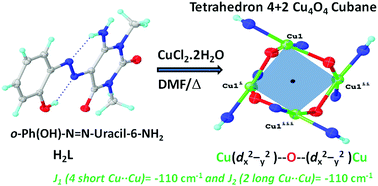Tetranuclear copper(ii) cubane complexes derived from self-assembled 1,3-dimethyl-5-(o-phenolate-azo)-6-aminouracil: structures, non-covalent interactions and magnetic property†
Abstract
Tetranuclear copper(II) complexes are of paramount importance in structural biology, and they are potential materials for magnetism and catalysis. To develop such a system, a new 6-aminoazouracil ligand, 1,3-dimethyl-5-(o-phenolate-azo)-6-aminouracil (H2L, 1) with a NuNaO (Nu, uracil-N and Na, azo-N) chromophore was synthesized and used to generate a noble discrete doubly opened Cu4O4 cubane-like cluster ([CuL]4·2H2O, 2.2H2O) for studying magnetism. The coordination environment of Cu(II) is distorted square planar linked through phenolate-μ2-O bridges. The ligand crystallizes in the monoclinic space group P121/c1 and the complex is in the tetragonal I41/a space group with an S4 symmetry. The ligand has two dissociable hydrogen atoms in the solution with pK1 4.91 (hydrazone proton) and pK2 9.68 (phenolic proton). In the solid state, the ligand exhibits displaced stacking (energy, −69.5 and −77.3 kJ mol−1 for the molecules A and B, respectively) and tetrel bonding interactions (energy, −43.8 kJ mol−1). In 2.2H2O, the symmetrical units are stacked to show weak noncovalent interactions. The magnetic property of 2.2H2O was investigated based on the cubane [Cu4O4] core and discussed in detail, resulting in the exchange coupling parameter [(J1 (short Cu⋯Cu distances) = −110.1(1) cm−1, J2 (long Cu⋯Cu distances) = −27.1(2) cm−1)] that indicate a strong antiferromagnetic interaction between tetranuclear copper(II) ions through μ-phenolate linkers, which is a result of the interaction of dx2−y2 orbitals in the square plane. The EPR study is concomitant with the results of magnetism. Thus, it could be a potential material in the field of antiferromagnetic spintronics as well.



 Please wait while we load your content...
Please wait while we load your content...